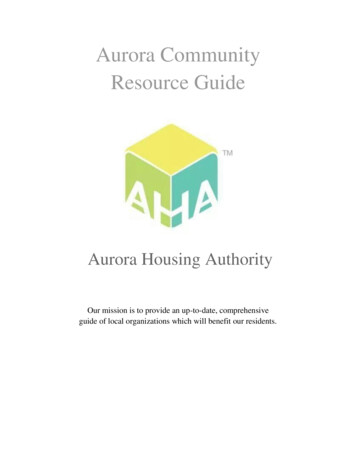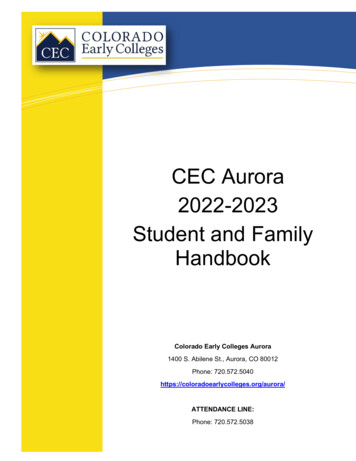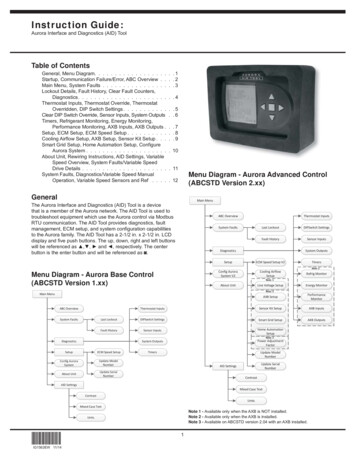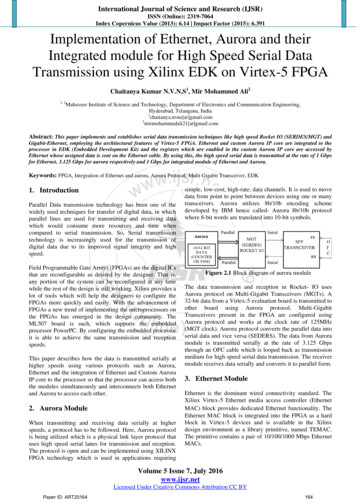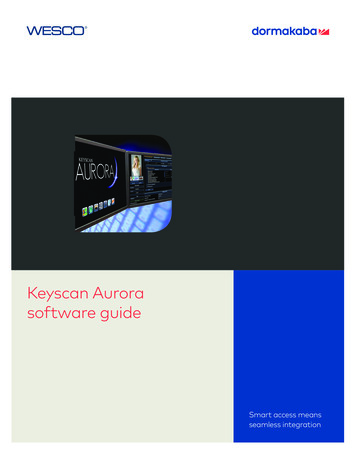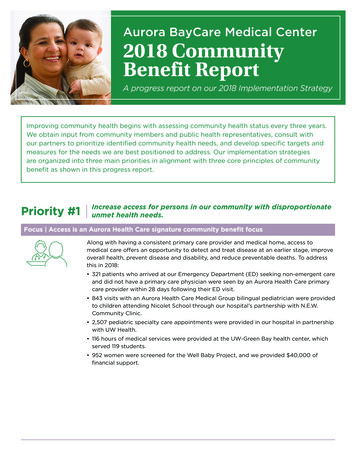
Transcription
Aurora BayCare Medical Center2018 CommunityBenefit ReportA progress report on our 2018 Implementation StrategyImproving community health begins with assessing community health status every three years.We obtain input from community members and public health representatives, consult withour partners to prioritize identified community health needs, and develop specific targets andmeasures for the needs we are best positioned to address. Our implementation strategiesare organized into three main priorities in alignment with three core principles of communitybenefit as shown in this progress report.Priority #1Increase access for persons in our community with disproportionateunmet health needs.Focus Access is an Aurora Health Care signature community benefit focusAlong with having a consistent primary care provider and medical home, access tomedical care offers an opportunity to detect and treat disease at an earlier stage, improveoverall health, prevent disease and disability, and reduce preventable deaths. To addressthis in 2018: 321 patients who arrived at our Emergency Department (ED) seeking non-emergent careand did not have a primary care physician were seen by an Aurora Health Care primarycare provider within 28 days following their ED visit. 843 visits with an Aurora Health Care Medical Group bilingual pediatrician were providedto children attending Nicolet School through our hospital’s partnership with N.E.W.Community Clinic. 2,507 pediatric specialty care appointments were provided in our hospital in partnershipwith UW Health. 116 hours of medical services were provided at the UW-Green Bay health center, whichserved 119 students. 952 women were screened for the Well Baby Project, and we provided 40,000 offinancial support.
Priority #2Build links between our clinical services and local communityhealth improvement plans.Focus Behavioral healthAccording to our hospital’s most recent Community Health Needs Assessment, mentalhealth and alcohol and other drug use (behavioral health) are ranked among the topfive health issues for Brown County. In 2016, 39.2% of adults in Brown County reportedbinge drinking in the past month, and the rate of age-adjusted opioid-related hospitalencounters was 311.4 per 100,000 population. To address this in 2018 we: Hosted “A Cause to Celebrate” fundraising event to benefit the Jackie Nitschke Center, alocal alcohol and other drug abuse treatment center. The event raised 75,000. Operated the Aurora Health Care Medical Group Suboxone Clinic to treat opioid drugaddiction within the community.Our hospital also remained actively engaged as a member organization of the HealthyBrown County Alcohol and Drug Task Force during 2018. Through this group, we: Developed four videos highlighting four community members who shared their storiesof personal struggles with drugs or alcohol. The task force will use these videos toeducate the public through showings in schools, churches, businesses, and other localvenues. Researched the following topics to help the group further shape its strategic plan:– The new “click and collect curbside pick-up” that some local stores provide and howthese programs regulate alcohol sales to prevent sales to minors.– Utilization trends for the “Safe Ride” program from local taverns so that we can recruitadditional establishments to join the program.– Data from “Place of Last Drink” to determine which establishments to target foreducation outreach.– Local municipalities that provide alcohol ordinances so that we may educate them onbest practice strategies.– Strategies to reduce the high rate of elderly falls at home related to alcoholconsumption.– Local housing options for people in recovery to support their transition aftertreatment.Donors raised their hands in celebration for funds raised in support of the JackieNitschke Center at the “A Cause to Celebrate” event in April 2018.
Priority #3Address the underlying causes of persistent health problems.Focus Nutrition, physical activity and overweight/obesityPhysical activity and nutrition ranked among the top five health issues for Brown Countyin 2016. To address this in 2018, we: Organized and supported Open Streets Green Bay, which benefitted more than 2,000community members who turned out to exercise. Hosted 840 individuals who participated in the 10th annual Aurora BayCare SpookySprint 1K/5K/10K. Helped complete a final version of the Community Health Improvement Plan. TheNutrition and Physical Activity task force will focus on safe community mobility, accessto healthy food for all income levels, and the American Medical Association hospitalhealthy food resolution 406. Provided 2,090 individuals with personal training services.– Actively participated inand supported four Wello(http://www.live54218.org/)community events.– Supported the AuroraBayCare Endurance Series.– 325 Aurora team membersparticipated in the AuroraBayCare Medical CenterLiveFit Prescription program.– 2,661 Aurora team membersmaintained an activemembership in our AuroraFamilies participated in the 10th Annual Spooky SprintBayCare Medical Center1K/5K/10K on Saturday, October 27, 2018.Fitness Center.Focus Youth injury preventionWisconsin Assembly Bill 259, signed into law in 2012, created statutes relating toconcussions and other head injuries sustained during youth athletic activities. This lawrequires that youth who may have sustained a concussion or head injury during an athleticactivity may not continue participating in the activity until they are assessed by a healthcare provider who has been trained in the evaluation and management of concussion andhead injuries. The law is designed to ensure the safety and well-being of our active youth.To address this in 2018, in addition to supporting 29 local athletic events, our LicensedAthletic Trainers provided: 286 youth sports physicals. 547 baseline concussion screenings for student athletes. Of these, 97 student athleteswith previous concussion baseline screenings were treated for concussion. 959 functional movement assessments for student athletes. 100 free health screenings and injury assessments for community members.
Focus Chronic diseasesChronic disease, long-lasting conditions that can usually be controlled but not alwayscured, ranked among the top five health issues for Brown County in 2016. People livingwith chronic illnesses must manage daily symptoms that affect their quality of life toavoid acute health problems or complications that could shorten their life expectancy. Tosupport community members with chronic diseases in 2018 our hospital focused on:Diabetes Conducted two Healthy Living with Diabetes sessions for 22 community members. Hosted a monthly diabetes management support group.Cancer Held four cancer educational sessions for 187 community members. Completed four skin cancer screenings at local community events. Supported 50 Aurora team members who participated in the Making Strides AgainstBreast Cancer walk, and we provided 5,000 in financial support to the AmericanCancer Society. Hosted three breast cancer support groups at our hospital for a total of 51 attendees.Heart Disease Provided 1,000 in financial support to stroke education initiatives and conducted 33heart/stroke education sessions at our hospital for 1,332 attendees. Provided 3,000 in financial support to the American Heart Association.Inflammatory Bowel Disease Provided 7,500 in financial support to the Colon Cancer Coalition. Hosted the Crohn’s walk on our hospital campus for 250 attendees.Hepatitis CAs part of Aurora’s population health strategy, 2,707 patients in Aurora’s Green Bay,Manitowoc, and Marinette service area were tested for hepatitis C; of those, 72 testedpositive, 31 had positive confirmatory tests, and 28 patients entered treatment during 2018.Focus Health professions education and workforce developmentThe Wisconsin Academy for Rural Medicine (WARM) is a medical education programfor students who intend to practice rural medicine. The goal of this program is to helpincrease the number of physicians who practice medicine in rural Wisconsin to helpimprove the health of rural Wisconsin communities. Aurora BayCare is one of threeregional sites participating in WARM. Our hospital hosted 13 medical students in theWARM program rotation during 2018. Of those: 1 student each went on to post-graduate medical education in primary care, internalmedicine, pediatrics, and OB/GYN. 13 students passed Step 1 and 8 students passed Step 2 standardized examinations.Additionally, our hospital team members remained committed to supporting healthprofessions students of all levels and from various programs seeking educationalopportunities within our facility, including continuing education opportunities for currentemergency medical service (EMS) professionals. During 2018: 9 EMS scholarship recipients remained in surrounding communities. 4 EMS huddle sessions were provided for 344 EMS professionals attending. 18,000 experience hours were provided to students seeking careers in healthprofessions.
Every gift canchange a life.Donate to a cause youAdvocateAuroracare abouttoday.Give Well CampaignDuring 2018, a total of 128hospital team members pledged 59,480 to the Advocate AuroraGive Well Campaign, their showof support to the not-for-profitagencies, organizations, andcauses in our community thatare most important to them.The campaign offers morethan 1,300 funds including 350Aurora funds, local United Wayagencies, and other not-forprofit organizations respondingto important community needs.Community benefits by the numbersFinancial assistance (charity care) at cost* 2,843,000 22,095,000Medicaid shortfall at cost*Other means-tested programs at cost*Subtotal 1,193,000 26,131,000Community health improvement and educationservices, and community benefit operations 694,763Health professions education 1,194,111Subsidized health services 137,500Other cash and in-kind contributions 324,809Subtotal 2,351,183Language assistance services** 119,426Volunteer services** 113,603Total 2018 Community Benefits*** 28,715,212* Cost-to-charge ratios are based on Wisconsin Hospital Association percentages.** In 2018, Advocate Health Care in Illinois and Aurora Health Care in Wisconsin joined together tocreate Advocate Aurora Health, the 9th largest not-for-profit health system in the country. TheState of Illinois requires the inclusion of graduate medical education expenses and the provision ofnon-employee volunteer and language-assistance services in community benefit reporting. Thesecategories have been added to Aurora’s public reports to create consistency across all AdvocateAurora Health community benefit reports.give.aurora.org*** Aurora Health Care has elected to exclude Medicare shortfalls and bad-debt expenses from thecommunity benefit calculations. However, when Medicare shortfalls are added, our hospital’s totalbenefit to the community is 75,363,212.To see our most recent Community Health Needs Assessment report and Implementation Strategy plan,please visit www.aurora.org/commbenefits.Aurora BayCare Medical Center2845 Greenbrier RoadGreen Bay, WI 54311KV0135c (7/19)
Aurora BayCare Medical Center 2018 Community Benefit Report . Developed four videos highlighting four community members who shared their stories of personal struggles with drugs or alcohol. The task force will use these videos to . The law is designed to ensure the safety and well-being of our active youth.



